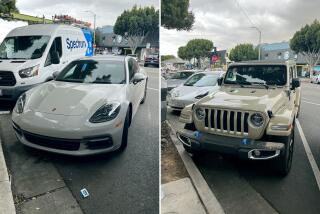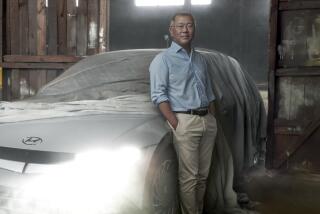Redesigned 2013 Santa Fe reflects Hyundai’s climb to legitimacy
- Share via
Parents aren’t supposed to pick favorites, but it’s clear Hyundai has a soft spot for its Santa Fe.
To hear the Korean automaker tell it, the crossover played a key role in Hyundai’s transformation from maker of meek little econoboxes with shoddy reliability to a brand that rivals the best from Honda and Toyota.
The third generation of the Santa Fe, rolling into dealerships now, demonstrates how far the company has come. This handsomely redesigned crossover is packed with utility and comes in two sizes: a five-passenger version and a seven-passenger model.
Photos: 2013 Hyundai Santa Fe and Santa Fe Sport
The larger Santa Fe offers a V-6 engine and a longer wheelbase and starts at $30,945. The smaller model, now called the Santa Fe Sport, starts at $25,295 and comes with either a four-cylinder engine or an optional (and regrettable) turbocharged four-cylinder.
The revisions to the Santa Fe lineup cap off a decade-long overhaul of Hyundai’s entire lineup. Though it took several generations for each vehicle, the effort has proved a stunning success.
Hyundai’s annual U.S. sales more than doubled to 703,007 from 2001 to 2012, according to Edmunds.com. During the same period, sales for the entire industry dropped 15%.
The climb to legitimacy started in 2001 with the introduction of the first Santa Fe. The automaker sold nearly a quarter million of the five-passenger crossovers in just the first three years it was offered, almost double what it expected.
This success resulted from several converging factors.
“If you think back to that point in time, there were not nearly as many players in that segment,” said Mike Wall, an auto analyst at IHS Automotive. “When Hyundai came out with [the Santa Fe], it had a compelling design; it was well packaged; it was affordable.”
But the early Santa Fe had a bit of help in finding buyers. Three years earlier, Hyundai took the remarkable step of offering a 10 year/100,000 mile warranty.
“Hyundai had to fight some quality battles early on,” Wall said. “The warranty started changing that conversation as the brand started to get its footing.”
Company President and CEO John Krafcik acknowledged as much when he introduced the Santa Fe to the media in March. “The Santa Fe is very, very important in our history,” Krafcik said. The warranty and the Sante Fe “were probably the things that set the pace for future growth and helped us get to where we are today.”
Like Hyundai itself, the Santa Fe has come a long way since its humble — and homely — debut.
The 2013 Santa Fe and Santa Fe Sport models look identical, save for differing lengths and slightly different passenger doors. Their upscale, bold design is a big improvement over the awkward, bug-eyed look of the original Santa Fe in 2001.
The interiors are also nearly identical, save for a third row of seats on the larger Santa Fe. This bigger Hyundai replaces the Veracruz and rides on a wheelbase about four inches longer than the Sport, and its overall length is 8.5 inches longer. The Santa Fe GLS holds seven people; the Santa Fe Limited has two captain’s chairs in the middle row for a total capacity of six people. The rear seats fold flat when not in use.
Both the smaller Sport model and the seven-passenger version include some clever use of space.
The rear seats on the Sport and middle seats on the GLS are split into three sections, and each folds separately. The retractable cargo cover on all models stores under the floor of the cargo area when not in use — helpful for anyone who’s lost theirs to a messy garage.
And on models with the Leather and Premium package, the middle row of seats slide fore and aft. A growing trend in minivans, this feature enables parents to move forward a cranky child for easy pacifier or juice box application.
The Santa Fe’s cabin is nicely bolted together, the dashboard thoughtfully laid out. Faux-wood trim adds a bit of character that’s lacking in other Hyundai interiors.
As with the number of seats, the two models diverge when it comes to their powertrains.
The base Sport — which competes against Chevy Equinox, Ford Edge and Toyota Venza — comes with a perfectly capable direct-injected, 2.4-liter four-cylinder engine. It makes 190 horsepower and 181 pound-feet of torque and pushes power to the front wheels via a smooth six-speed automatic transmission. Hyundai made the engine’s job easier by using plenty of high-strength steel, which dropped about 260 pounds from the weight of the Santa Fe.
Hyundai says this model is estimated to get 21 mpg in the city and 29 mpg on the highway. In our week of testing this model, we averaged 23 mpg. All-wheel-drive adds $1,750 to the sticker price, and drops fuel economy down to 20 mpg in the city and 26 mpg on the highway.
Standard gear on the Sport includes alloy wheels, keyless entry, a stereo system with Sirius satellite radio and Bluetooth, seven air bags, and traction and stability control. If that’s not enough spice for your quesadilla, Hyundai also offers the more upmarket turbocharged Sport for an extra $3,250. A drop from 29 mpg to 27 mpg on the highway seems reasonable, especially when it’s the result of 264 total horsepower from this 2.0-liter engine.
Reasonable until you get the turbo engine on the road. If it’s faster, it doesn’t feel like it. Dead spots in the power curve make you wonder if something crawled into the fuel line.
Compounding this is a six-speed automatic transmission that hunts excessively for the right gear and lags when a quick downshift is needed. Abrupt shifts also cause occupants’ heads to bob slightly with each new gear.
Our advice: Forget the turbo. The better-executed base model has enough power for less money.
Buyers who step up to the larger Santa Fe get a 3.3-liter, direct-injected V-6 that makes 290 horsepower and 252 pound-feet of torque. Like its little brother, the Santa Fe is front-wheel-drive. (AWD adds $1,750.) A six-speed automatic transmission is your only gearbox option.
This Santa Fe’s peers include the Honda Pilot, Toyota Highlander, Nissan Pathfinder and Mazda CX-9. Though the Santa Fe is the lightest of these competitors and has the most horsepower, you can’t tell from the driver’s seat. The gearbox and the engine feel a bit sluggish as they work to get you onto the highway or from a stop.
But daily driving in both Sante Fe models is pleasant; they handle well for crossovers and are quiet and comfortable on the road. Hyundai even went so far as to include on all models a driver-selectable steering system, which gives three different levels of steering resistance. Unfortunately, all three are variations of numb. This being a Hyundai, practically the only thing without a warranty are the warranties. There’s a new vehicle warranty, powertrain warranty, anti-perforation warranty on the body, even a California emissions warranty. All of this is free, plus five years of roadside assistance.
But Hyundai no longer needs warranties to convince consumers it can play in the same league as Toyota and Honda. Nor does it need to discount its vehicles to sell them. A loaded Santa Fe Sport AWD Turbo can approach $36,000, and the larger Santa Fe AWD tops out around $39,000. These models come with features including heated leather seats, a heated steering wheel, touch-screen navigation system, backup camera and a panoramic sunroof. The prices are certainly competitive, but they aren’t the bargain-basement offerings from Hyundai’s early days in the U.S. market.
If the Santa Fe and Santa Fe Sport are any indication, Hyundai has evolved to a point where it is known not only as a rival to established brands, but an equal.
No wonder Hyundai likes its Santa Fe.
david.undercoffler@latimes.com
More to Read
Inside the business of entertainment
The Wide Shot brings you news, analysis and insights on everything from streaming wars to production — and what it all means for the future.
You may occasionally receive promotional content from the Los Angeles Times.










